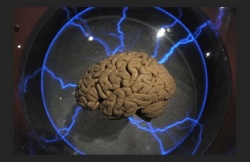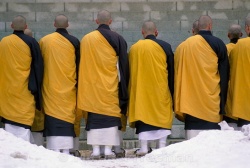Bodhicitta
In Buddhism, bodhicitta (Sanskr. बोधिचित्त, Ch. 菩提心, putixin, Jp. bodaishin, Tibetan བྱང་ཆུབ་ཀྱི་སེམས་,Wyl. byang chub kyi sems) jang chub sem, Mongolian бодь сэтгэл), "enlightenment-mind", is the mind that strives toward awakening and compassion with all sentient beings.
Etymology
Etymologically, the word is a combination of the Sanskrit words bodhi and citta. Bodhi means "awakening" or "enlightenment". Citta is derived from the Sanskrit root cit, and denotes "that which is conscious" – mind or consciousness. Bodhicitta may be translated as "awakening mind" or "mind of enlightenment".
Definition
Bodhicitta is the intention to achieve omniscient Buddhahood (Trikaya) as fast as possible, so that one may benefit infinite sentient beings. One who has bodhicitta as the primary motivation for all of his or her activities is called a bodhisattva.
Bodhicitta is the union of compassion and wisdom. This is a development of the concept of luminous mind in the Pali Canon.
Bodhicitta also means the aim to, on the one hand, bring happiness to all sentient beings, and on the other, to relieve them of suffering.
The term bodhicitta in its most complete sense would combine both:
- the arising of spontaneous and limitless compassion for all sentient beings, and
- the falling away of the attachment to the illusion of an inherently existent self.
Levels of bodhicitta
A distinction can be made between relative and absolute bodhicitta:
- Relative bodhicitta refers to a state of mind in which the practitioner works for the good of all beings as if it were his own.
- Absolute, or ultimate, bodhicitta, refers to the wisdom of shunyata (śunyatā, a Sanskrit term often translated as "emptiness", though the alternatives "openness" or "spaciousness" probably convey the idea better to Westerners). The concept of śunyatā in Buddhist thought does not refer to nothingness, but to freedom from attachments and from fixed ideas about the world and how it should be.
Some bodhicitta practices emphasize the absolute (e.g. vipaśyanā), while others emphasize the relative (e.g. metta), but both aspects are seen in all Mahāyāna practice as essential to enlightenment, especially in the Tibetan practices of tonglen and lojong. Without the absolute, the relative can degenerate into pity and sentimentality, whereas the absolute without the relative can lead to nihilism and lack of desire to engage other sentient beings for their benefit.
Patrul Rinpoche states that there are different levels of bodhicitta:
- The lowest level is the way of the King, who primarily seeks his own benefit but who recognizes that his benefit depends crucially on that of his kingdom and his subjects.
- The middle level is the path of the boatman, who ferries his passengers across the river and simultaneously, of course, ferries himself as well.
- The highest level is that of the shepherd, who makes sure that all his sheep arrive safely ahead of him and places their welfare above his own.[3]
Although classification systems do vary (some schools even denying any conceptualizing of the path to Buddhahood) e.g. yellow hats argue that with bodhicitta one enters the path of accumulation
Origins and development
Luminous mind and bodhicitta
Luminous mind (also, "brightly shining mind," "brightly shining citta") is a term used by the Buddha in the Pali Canon. It is described as the most fundamental aspect of the mind, and is said to be "brightly shining" whether or not this is realized. It is given no direct doctrinal interpretation in the Pali discourses; one way the Mahāyanā interprets it is as bodhicitta. The Astasahasrika Perfection of Wisdom Sūtra describes bodhicitta thus:
- That citta is no citta since it is by nature brightly shining.'
This is in accord with Anguttara Nikaya I,10 which goes from a reference to brightly shining citta to saying that even the slightest development of loving-kindness is of great benefit. This implies that loving-kindness - and the related state of compassion - is inherent within the luminous mind as a basis for its further development. The observation that the ground state of consciousness is of the nature of loving-kindness implies that empathy is innate to consciousness and exists prior to the emergence of all active mental processes. Source Texts
Among the most important source texts on bodhichitta, within the Mahāyāna tradition in which the teaching arose, are:
- Śāntideva's A Guide to the Bodhisattva's Way Of Life (c. 700 CE),
- Thogme Zangpo's Thirty-Seven Practices of a Bodhisattva (12th century CE),
- Langri Tangpa's Eight Verses for Training the Mind (c. 1100 CE), and
- the lojong (mind training) proverbs authored by Geshe Chekhawa in the 12th century CE.
Practice
Mahayana Buddhism propagates the Bodhisattva-ideal, in which the Six perfections are being practiced. Arousing bodhicitta is part of this Bodhisattva-ideal. Bodhisattva ideal
In Mahāyāna and Vajrayāna Buddhism, the goal of Buddhist practice is primarily to be reborn infinite numbers of times to liberate all those other beings still trapped in samsāra.
Paramitas
Mahāyāna Buddhism teaches that the broader motivation of achieving one's own enlightenment "in order to help all sentient beings" is the best possible motivation one can have for any action, whether it be working in one's vocation, teaching others, or even making an incense offering. The Six Perfections (Pāramitās) of Buddhism only become true "perfections" when they are done with the motivation of bodhicitta. Thus, the action of giving (Skt. dāna) can be done in a mundane sense, or it can be a Pāramitā if it is conjoined with bodhicitta. Bodhicitta is the primary positive factor to be cultivated.
Cultivation
The Mahāyāna-tradition provides specific methods for the intentional cultivation of both absolute and relative bodhicitta. This cultivation is considered to be one of the most difficult aspects of the path to complete awakening. Practitioners of the Mahāyāna make it their primary goal to develop a genuine, uncontrived bodhicitta which remains within their mindstreams continuously without having to rely on conscious effort.
Among the many methods for developing uncontrived Bodhicitta given in Mahāyāna teachings are:
- Contemplation of the Four Immeasurables (Brahmaviharas):
- Immeasurable Loving-Kindness (Maitri),
- Immeasurable Compassion (Karunā),
- Immeasurable Joy in the Good Fortune of Others (Mudita), and
- Immeasurable Equanimity (Upeksa)
- The practice of the Pāramitās (Generosity, Patience, Virtue, Effort, Meditation, and Insight).
- The Taking and Sending (tonglen) practice, in which one takes in the pain and suffering of others on the inbreath and sends them love, joy, and healing on the outbreath, and the Lojong ('Mind Training') practices of which tonglen forms a part.
- Viewing all other sentient beings as having been our mothers in infinite past lives, and feeling gratitude for the many occasions on which they have taken care of us.
Universal bodhicitta
The practice and realization of bodhicitta are independent of sectarian considerations, since they are fundamentally a part of the human experience. Bodhisattvas are not only recognized in the Theravāda school of Buddhism, but in all other religious traditions and among those of no formal religious tradition. The present fourteenth Dalai Lama, for instance, regarded Mother Teresa as one of the greatest modern bodhisattvas.

